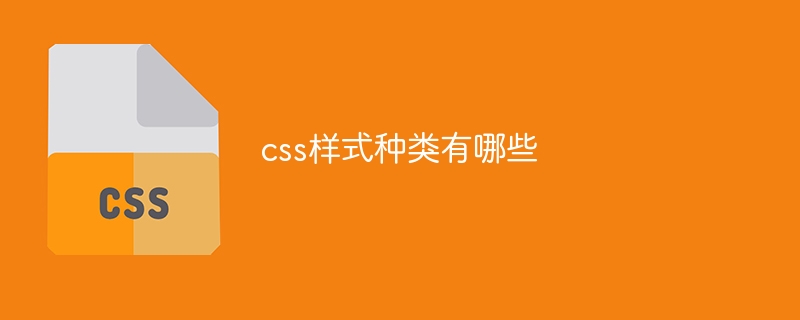What are the types of css styles?
CSS style types include: basic styles (fonts, colors, borders, padding/margins), layout styles (floating, positioning, display, grid layout, flexible layout), special effects (transition, animations, transformations, filters, blending modes), table styles (table display, table data), and other styles (media queries, custom properties, animation timelines).

CSS style types
Cascading style sheets (CSS) provide a variety of styling options that can be used to enhance the appearance of web pages. Appearance and layout. These styles can be divided into the following main categories:
1. Basic Style:
- Font: Controls the font family, size and style.
- Color:Set the color of text, background and border.
- Border: Add a border to an element and control its width, style and color.
- Padding and margins: Add space inside or outside an element.
2. Layout style:
- Floating: Allows elements to be aligned horizontally along the page.
- Positioning: Fix an element at a specific location or position it relative to other elements.
- Display: Control the visibility of elements and determine how they interact with other elements.
- Grid Layout: Create a grid-based page layout for easy display across devices.
- Flexible Layout: Allows elements to dynamically adjust as the window size changes.
3. Special Effects:
- Transition: Transition smoothly between attributes.
- Animation: Create animation sequences to enhance web page interactivity.
- Transform: Rotate, scale, or tilt the element.
- Filters: Apply image effects such as blur, hue adjustment, or saturation.
- Blending Mode: Mix the styles of multiple elements to create unique effects.
4. Table style:
- Table display: Control the appearance of the table, including borders, cell spacing and Alignment.
- Table data: Style table data, including text, values and links.
5. Other styles:
- Media queries: Switch styles based on screen size, device type or other conditions.
- Custom Properties: Create reusable variables that can be easily applied across styles.
- Animation Timeline: Coordinate the playback of animation sequences.
The above is the detailed content of What are the types of css styles?. For more information, please follow other related articles on the PHP Chinese website!

Hot AI Tools

Undresser.AI Undress
AI-powered app for creating realistic nude photos

AI Clothes Remover
Online AI tool for removing clothes from photos.

Undress AI Tool
Undress images for free

Clothoff.io
AI clothes remover

Video Face Swap
Swap faces in any video effortlessly with our completely free AI face swap tool!

Hot Article

Hot Tools

Notepad++7.3.1
Easy-to-use and free code editor

SublimeText3 Chinese version
Chinese version, very easy to use

Zend Studio 13.0.1
Powerful PHP integrated development environment

Dreamweaver CS6
Visual web development tools

SublimeText3 Mac version
God-level code editing software (SublimeText3)

Hot Topics
 1387
1387
 52
52
 How to use bootstrap in vue
Apr 07, 2025 pm 11:33 PM
How to use bootstrap in vue
Apr 07, 2025 pm 11:33 PM
Using Bootstrap in Vue.js is divided into five steps: Install Bootstrap. Import Bootstrap in main.js. Use the Bootstrap component directly in the template. Optional: Custom style. Optional: Use plug-ins.
 The Roles of HTML, CSS, and JavaScript: Core Responsibilities
Apr 08, 2025 pm 07:05 PM
The Roles of HTML, CSS, and JavaScript: Core Responsibilities
Apr 08, 2025 pm 07:05 PM
HTML defines the web structure, CSS is responsible for style and layout, and JavaScript gives dynamic interaction. The three perform their duties in web development and jointly build a colorful website.
 How to write split lines on bootstrap
Apr 07, 2025 pm 03:12 PM
How to write split lines on bootstrap
Apr 07, 2025 pm 03:12 PM
There are two ways to create a Bootstrap split line: using the tag, which creates a horizontal split line. Use the CSS border property to create custom style split lines.
 Understanding HTML, CSS, and JavaScript: A Beginner's Guide
Apr 12, 2025 am 12:02 AM
Understanding HTML, CSS, and JavaScript: A Beginner's Guide
Apr 12, 2025 am 12:02 AM
WebdevelopmentreliesonHTML,CSS,andJavaScript:1)HTMLstructurescontent,2)CSSstylesit,and3)JavaScriptaddsinteractivity,formingthebasisofmodernwebexperiences.
 How to resize bootstrap
Apr 07, 2025 pm 03:18 PM
How to resize bootstrap
Apr 07, 2025 pm 03:18 PM
To adjust the size of elements in Bootstrap, you can use the dimension class, which includes: adjusting width: .col-, .w-, .mw-adjust height: .h-, .min-h-, .max-h-
 How to use bootstrap button
Apr 07, 2025 pm 03:09 PM
How to use bootstrap button
Apr 07, 2025 pm 03:09 PM
How to use the Bootstrap button? Introduce Bootstrap CSS to create button elements and add Bootstrap button class to add button text
 How to set up the framework for bootstrap
Apr 07, 2025 pm 03:27 PM
How to set up the framework for bootstrap
Apr 07, 2025 pm 03:27 PM
To set up the Bootstrap framework, you need to follow these steps: 1. Reference the Bootstrap file via CDN; 2. Download and host the file on your own server; 3. Include the Bootstrap file in HTML; 4. Compile Sass/Less as needed; 5. Import a custom file (optional). Once setup is complete, you can use Bootstrap's grid systems, components, and styles to create responsive websites and applications.
 How to insert pictures on bootstrap
Apr 07, 2025 pm 03:30 PM
How to insert pictures on bootstrap
Apr 07, 2025 pm 03:30 PM
There are several ways to insert images in Bootstrap: insert images directly, using the HTML img tag. With the Bootstrap image component, you can provide responsive images and more styles. Set the image size, use the img-fluid class to make the image adaptable. Set the border, using the img-bordered class. Set the rounded corners and use the img-rounded class. Set the shadow, use the shadow class. Resize and position the image, using CSS style. Using the background image, use the background-image CSS property.




